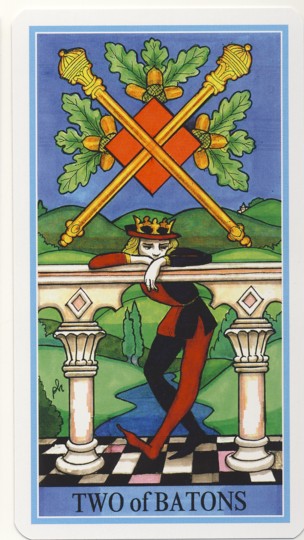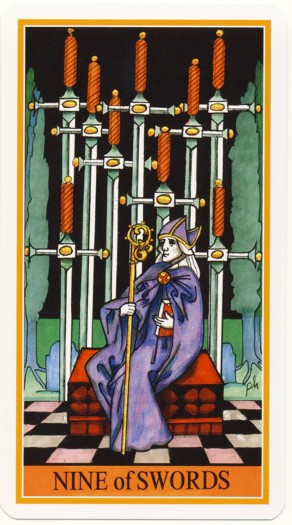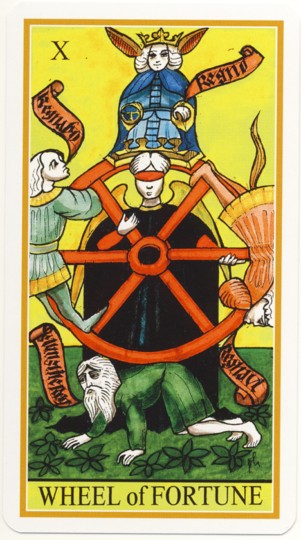Huson is a long-time participant in the tarot world. He is the author of The Devil’s Picture Book (1971) and Mystical Origins of the Tarot (Inner Traditions, 2004), books on witchcraft and a few fictional novels. He also has an impressive list of film and television production credentials.
Huson’s extensive experience in the world of mysticism and divination benefits this tarot deck. The Dame Fortune’s Wheel Tarot is unusual in several respects. The card designs reference historic Italian and French tarots from the medieval and early Renaissance. The artwork resembles those early wood-cut prints but is more sophisticated in composition and color. The designs are well-thought and planned. Background colors unify the suit cards, and a contained color palette adds to the consistent card images.
The most unusual feature of this deck is the pip cards, which are a departure from the RWS canon. The pip cards feature images that reflect Etteilla’s divinatory meanings. Etteilla was a French mystic and one of the earliest authors that wrote about using tarot decks for divination, and also designed his own early tarot deck that included esoteric symbols. While some of Etteilla’s pip-card meanings persist (due to, as some say, being ripped off by Waite without any credit), some are quite a bit different from contemporary divinatory meanings. These are offered in the accompanying LWB.
For example, the meaning given for the 2 of Batons in the little white book is, “Keyword: Sadness. Meaning: Melancholy, affliction, displeasure, dark thoughts, sourness, spite. Reversed: Surprise, astonishment, marvel.” This is a significant departure from the contemporary meaning of contemplating possibilities and evaluating ambitions. The 9 of Swords provides another stark example, “Keyword: Celibate. Meaning: Bachelor, virgin, religious man or woman, religion, piety, honesty. Reversed: Mistrust, doubt, fear, timidity, shame.” The upright meaning is completely different from commonly-accepted contemporary meanings. This is the only deck I’ve seen that adheres to Etteilla’s early catalog of pip meanings, a quality that makes it immensely valuable for tarot scholars and collectors.

This deck includes a single significator card. Some of the trump titles are modified: the Magician is the Juggler; the High Priestess is the Female Pope; the Lovers are more simply Love; Strength is Fortitude (#11). The suits follow the common elemental assignments (Batons/Wands = Fire), but the elemental aspect of the tarot isn’t emphasized beyond noting the attributions. The suit names are Batons, Cups, Swords, and Coins. Huson relates each suit to a cardinal virtue: Fortitude, Temperance, Justice, and Prudence, respectively.
The Court Cards have unique features, too. The Knaves (Pages) are each associated with heroic figures of early medieval literature: the Knave of Batons with Hector, prince of Troy; Knave of Cups with Paris, prince of Troy; Knave of Swords with Ogier the Dane (also Olger or Holger, a character from Chason de Roland); and Knave of Coins with Lancelot du Lac. The Queens and Kings are also associated with famous literary figures: The King of Batons is Julius Caesar, the Queen is Rachel, wife of Jacob; the King of Cups is Charlemagne, the Holy Roman Emperor, and his Queen is Judith, the slayer of Holofernes. The King of Swords is David, King of Israel, and his Queen is Pallas Athena. The King of Coins is Alexander of Macedon and his Queen is Argine, the queen of Avalon. A bit of research on these characters makes it clear why each was chosen for the particular court card. The characters are traditional assignments for 52-card playing deck court cards.

This is a unique and exceptionally well-done tarot deck that departs from its contemporaries by going backwards to Etteilla and the early Renaissance tarots. That in itself is a very unusual combination! Highly recommended for tarot scholars and collectors; also a worthwhile acquisition for tarot readers who would like to study Etteilla’s original pip-card meanings.
~review by Elizabeth Hazel
Creator: Paul Huson
Lo Scarabeo, 2009
79 cards plus 63-page little white book in four languages, in tuck box. $19.44

